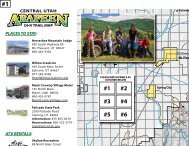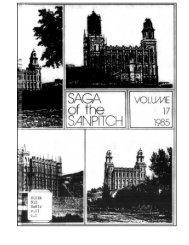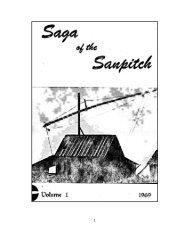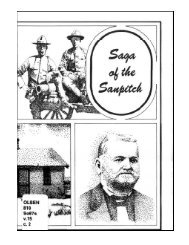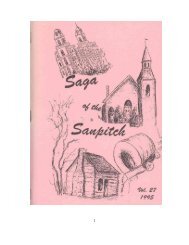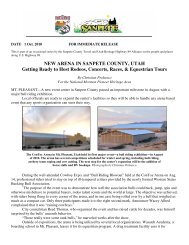Saga of the Sanpitch Volume 13, 1981 - Sanpete County
Saga of the Sanpitch Volume 13, 1981 - Sanpete County
Saga of the Sanpitch Volume 13, 1981 - Sanpete County
- TAGS
- saga
- sanpitch
- volume
- sanpete
- sanpete.com
Create successful ePaper yourself
Turn your PDF publications into a flip-book with our unique Google optimized e-Paper software.
carry a single boy downstream we would hold hands, forming a chain with two tall boys, Ed Jensen and Elmer<br />
(Gus) Anderson, on <strong>the</strong> ends <strong>of</strong> <strong>the</strong> chain.<br />
In pioneer times <strong>the</strong>re were no regulations governing <strong>the</strong> use <strong>of</strong> <strong>the</strong> watershed. It was free and open.<br />
William Henry Peacock used to drive his band <strong>of</strong> brood mares into <strong>the</strong> canyon in February. Till <strong>the</strong> new grass<br />
grew, <strong>the</strong>re was dry bunch grass below <strong>the</strong> ledges on <strong>the</strong> steep sunny slopes. Sheepmen jockeying for position<br />
drove <strong>the</strong>ir bands <strong>of</strong> lambed-out ewes into <strong>the</strong> canyon before <strong>the</strong> feed was ready.<br />
The inevitable result was extremely heavy run<strong>of</strong>f at snowmelt and destructive floods following heavy<br />
summer rains. Before <strong>the</strong> sedimentation dam was built, high water carried heavy loads <strong>of</strong> sand and gravel to<br />
<strong>the</strong> first point where <strong>the</strong> creek bed flattened. As <strong>the</strong> channel filled, <strong>the</strong>re was serious flooding. The city hired<br />
men with teams and scrapers to keep <strong>the</strong> channel open. Because stream flow was highest at night, it was<br />
necessary to work nights. Some <strong>of</strong> <strong>the</strong> men wore hip boots; o<strong>the</strong>rs, including our neighbor, Hyrum Dennison,<br />
waded in <strong>the</strong> icy water in work shoes. That activity gave rise to <strong>the</strong> unsightly hump just west <strong>of</strong> <strong>the</strong> new high<br />
school.<br />
The watershed provided considerable work. One <strong>of</strong> my first jobs on <strong>the</strong> forest was helping Francis M.<br />
Cox dig up small spruce trees. These we planted in what was <strong>the</strong>n <strong>the</strong> barren triangular tip <strong>of</strong> <strong>the</strong> cemetery.<br />
How tall those trees have grown!<br />
My most poignant recollection <strong>of</strong> Manti Creek dates back to June 14, 1906, <strong>the</strong> day that Neils<br />
Rasmussen was drowned in it. He had been hired to keep <strong>the</strong> divider <strong>of</strong> <strong>the</strong> two creeks free from driftwood.<br />
Accidentally he fell into <strong>the</strong> smaller south fork. He had no chance for survival. Word <strong>of</strong> <strong>the</strong> tragedy spread<br />
immediately. I hopped onto a horse and went galloping downtown. My first stop was at a crossing near <strong>the</strong><br />
Jorgensen home, west <strong>of</strong> Main Street, where men and boys on horseback were watching <strong>the</strong> stream for a<br />
corpse. After an unsuccessful pause, we rode on to lower observation points. West <strong>of</strong> town we were stopped<br />
by a barbed wire fence that crossed <strong>the</strong> creek. As we watched, a body hit a submerged wire and was flipped<br />
into view. If my memory is correct, it was Henry Mackay who rode into <strong>the</strong> stream to recover <strong>the</strong> body.<br />
High water flow was not all bad. Excess water made it possible to cultivate more land. <strong>Sanpete</strong> was<br />
known as <strong>the</strong> bread basket <strong>of</strong> <strong>the</strong> state at that period in time. I recently read that one unpr<strong>of</strong>itable shipment<br />
<strong>of</strong> wheat grown in <strong>Sanpete</strong> was made to Liverpool, England. One evening when our family was out for a buggy<br />
ride, we counted 21 stacks <strong>of</strong> unthreshed grain on a single farm on <strong>the</strong> east side <strong>of</strong> <strong>the</strong> highway between<br />
Shand's Knoll and Ephraim. Production on that farm today is skimpy because <strong>of</strong> water shortage. Shrinkage<br />
in <strong>the</strong> water supply resulted in abandonment <strong>of</strong> <strong>the</strong> highline Patton and Madsen ditches.<br />
Actually <strong>the</strong>re is less good land available at Manti now than at <strong>the</strong> turn <strong>of</strong> <strong>the</strong> century. The swamp has<br />
been creeping outward. Acreage on both sides <strong>of</strong> <strong>the</strong> railway track, a short distance north <strong>of</strong> Manti, has<br />
changed from first-class land to swamp. The reason for this change is not entirely clear, but it may be due to<br />
increased subterranean flow to <strong>the</strong> swamp due to changed management <strong>of</strong> <strong>the</strong> watershed.<br />
And what will <strong>the</strong> future <strong>of</strong> Manti Greek be? Much <strong>of</strong> <strong>the</strong> vegetation on <strong>the</strong> watershed is <strong>of</strong> poor<br />
quality. Future population pressure may make it economically feasible to eradicate trash vegetation that<br />
consumes precious water and to substitute pr<strong>of</strong>itable species. Then, too, geneticists may be able to splice <strong>the</strong><br />
genes <strong>of</strong> highly nutritious plants upon those <strong>of</strong> swamp grasses.<br />
Experience tells us one thing: whe<strong>the</strong>r <strong>the</strong> creek behaves like a beneficent, grand old dame or a holy<br />
terror will depend on how wisely <strong>the</strong> watershed is managed.<br />
41



